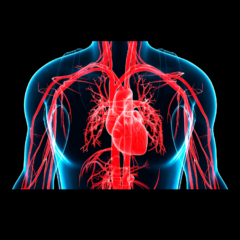Last updated on
Clot Chronicles: Screening for Atrial Fibrillation
Hello, I’m Dr. Elliott Antman from the Brigham and Women’s Hospital in Boston. I’m a cardiologist here at the Brigham and today we’re going to be talking about a very common rhythm disturbance called atrial fibrillation.
So, let’s understand what atrial fibrillation is. Here we have a model of the heart; it’s, of course, much bigger than the actual human heart. I’m going to take the front off, so that you can see the inside. There are four chambers: the right atrium, right ventricle, left atrium, and left ventricle.
Normally, the heartbeat starts in the top righthand corner; this is called the sinoatrial node and it’s a native pacemaker of the heart. The electrical signal from that native pacemaker goes to the center of the heart, the atrioventricular node, or AV node, and then goes down to both ventricles.
Patients who have atrial fibrillation have a disordered sequence of electrical activation of the heart. The top portion of the heart, the atria, quivers, perhaps, 300-500 times per minute. Unfortunately, not every one of those little quivering motions makes it through to the ventricles at the bottom because of a filtering capacity at the AV node.
Now how many people have atrial fibrillation? It’s estimated that in 2010, about 6 million people in the United States have atrial fibrillation. It’s seen more commonly as individuals get older, and it’s seen more commonly in individuals who have some form of heart disease or risk factors for heart disease. Now with the aging of the population, it’s projected that by 2030, we could see 12 million people with atrial fibrillation in the United States.
How do we detect atrial fibrillation in clinical practice? Well, the very simple tool, the 12-lead electrocardiogram, or ECG, is a 10-second recording of the electrical activity of the heart. And that’s wonderful because it’s readily available in all doctors’ offices and clinics, and it has a well-understood prediction rate for atrial fibrillation. But it depends on how frequently the patient is having episodes of atrial fibrillation. If they’re in it all the time, a condition called chronic or permanent atrial fibrillation, we can detect it with a simple 10-second, 12-lead ECG recording.
The literature says there’s somewhere between 5-25% yield with a 12-lead electrocardiogram, but that’s not good enough. The reason is that we need to do something for the patient with atrial fibrillation. We actually have to give them some form of antithrombotic therapy – interesting for listeners of the NATF Clot Chronicles. In addition, individuals who have atrial fibrillation may need special treatment to keep their heart from going too fast, or they may need a procedure called ablation where we actually do little lesion development in the heart to prevent atrial fibrillation from recurring.
So, people have come up with other ways to detect atrial fibrillation. And these are called Holter monitors—they’ve been around for decades—and you can record every single heartbeat over a 24- or a 48-hour period. Now that’s fine, and it has a very good yield if a person is having frequent episodes of atrial fibrillation, or if they’re in it all the time.
It is very good for determining the burden of atrial fibrillation – how much atrial fibrillation is occurring in a 24-hour period. But here’s the problem. If an individual doesn’t have frequent episodes of atrial fibrillation, you could simply miss it during that 24- or 48-hour period that a person is wearing a Holter monitor.
So, people have come up with other ways to record an electrocardiogram or some kind of electrical recording from the heart. These are called event monitors, and they come in two forms. The first form is called a looping event recorder. And what that means is that the device actually has an algorithm or some method for determining whether or not atrial fibrillation is present. What we have to have, of course, is some way of recording that electrical activity while the individual has the electrodes on or some form of monitoring that’s attached to them. So, originally these looping event recorders had electrodes that were placed on the patient’s chest. And they were worn for 2 weeks or 4 weeks. And during that period of time, one could determine whether or not atrial fibrillation was present. Now these are very good devices, but the problem is that individuals find them cumbersome.
So, there have been some advances in the technology – a wireless form of a looping recorder has been developed. And most interestingly, there have been a number of companies who have developed different ways of recording the electrical activity of the heart from devices that individuals wear all the time, like a watch. So there are a number of companies that have made looping recorders that are basically a watch with some special technology built into it, and that’s not bad.
Now, non-looping recorders are the other kind of event monitor, and those are used when a patient feels symptoms in a regularity of the heartbeat, some palpitations, shortness of breath, or lightheadedness. And they take the device and place it on their chest, and that records the electrical activity of the heart when they place it on their chest. And again, some interesting technology has developed where individuals can actually carry a little device that talks to their smartphone. And it’s a small form of an electrical recording device that they hold in their hand, and it can record their electrocardiogram signal directly into their smartphone. Now all that is very interesting, and we can see, perhaps, 50-75% of individuals who actually have atrial fibrillation detected with one of these event recorder devices.
What does the future hold for detection of atrial fibrillation? That’s where it gets very interesting. There are some techniques now to actually look at the flow of blood in a person’s face. And with some very sophisticated visual processing—image processing technology—it’s possible to see a normal, regular pattern of blood coursing through the blood vessels in the skin or in an irregular pattern. This is called visual plethysmography, and some researchers have actually been able to detect atrial fibrillation quite accurately using that special imaging processing technique.
And finally—perhaps you’ve all heard about—machine learning or artificial intelligence, which is sometimes now referred to as augmented intelligence. And there are some researchers who are looking at the 12-lead electrocardiogram when the heart is in regular rhythm—not in atrial fibrillation—and can actually read some subtle signs during regular rhythm that an individual might be at risk for atrial fibrillation.
So, lots of interesting ways to record atrial fibrillation in clinical practice. We’ve seen the ways that we use it now, and the future has some fascinating technology that we need to understand a little bit more about. But there are lots of new ways to detect atrial fibrillation, and that’s important.
This is Elliott Antman for Clot Chronicles.



